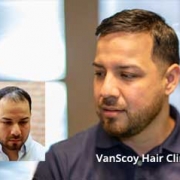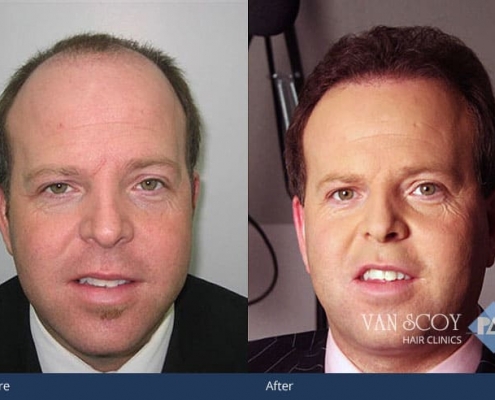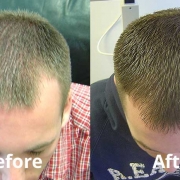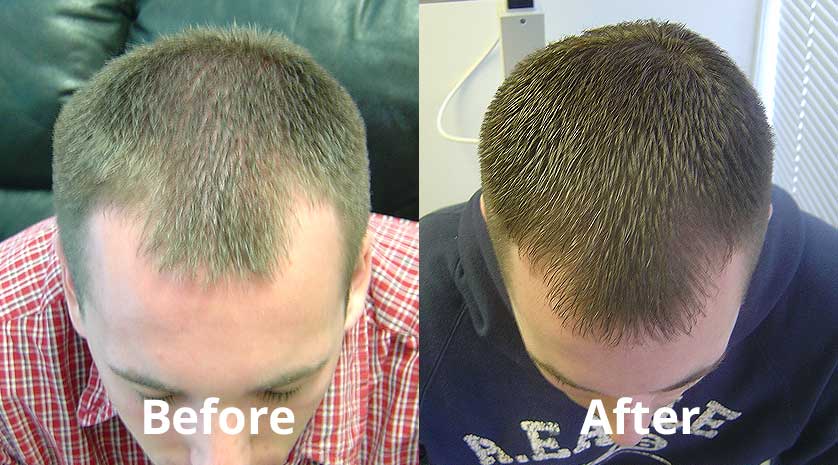Hair Regrowth Solutions in 2025
Androgenetic alopecia, commonly known as male pattern baldness, affects approximately 50 million men in the United States alone. This hereditary condition is characterized by a gradual thinning of hair, typically beginning at the temples and crown. The primary culprit is dihydrotestosterone (DHT), a hormone derived from testosterone that shrinks hair follicles until they can no longer produce visible hair.

While genetics play a significant role, other factors contributing to hair loss include:
- Age-related hormonal changes
- Stress and lifestyle factors
- Medical conditions and medications
- Nutritional deficiencies
- Environmental factors
At Van Scoy Hair Clinic, each client’s experience with hair loss is unique, which is why we offer personalized consultations to identify the specific causes and develop targeted treatment plans.
Advanced Hair Regrowth Solutions in Cleveland
Hair Transplant Surgery: Permanent, Natural-Looking Results
For men seeking a permanent solution to hair loss, hair transplant surgery represents the gold standard in hair restoration technology. Van Scoy Hair Clinic specializes in state-of-the-art transplant techniques that deliver natural-looking results.
Our surgeons utilize two primary methods:
Follicular Unit Transplantation (FUT) – This technique involves removing a strip of hair-bearing skin from the back of the scalp (the donor area), which is then dissected into individual follicular units and transplanted to areas experiencing thinning or baldness.
Follicular Unit Extraction (FUE) – A more advanced method where individual hair follicles are extracted directly from the donor area and transplanted to the recipient sites, leaving minimal scarring.
Both procedures are performed under local anesthesia, with recovery times ranging from a few days to a couple of weeks. New hair growth typically begins within 3-4 months after surgery, with full results visible after approximately one year.
Enhanced Plasma Therapy: Harnessing Your Body’s Natural Healing Power
Enhanced Plasma (EPT) therapy represents a groundbreaking approach to hair restoration that leverages your body’s own regenerative capabilities. This minimally invasive procedure involves:
- Drawing a small amount of blood from your arm
- Processing it in a centrifuge to concentrate the platelets
- Injecting the platelet-rich plasma into targeted areas of the scalp
The growth factors contained in platelets stimulate dormant hair follicles, encouraging new growth and strengthening existing hair. Clinical studies have shown that EPT can increase hair count, thickness, and the growth phase of the hair cycle.
Our EPT hair loss treatments typically involve a series of 3-4 sessions spaced 4-6 weeks apart, with maintenance treatments recommended every 6-12 months.
Laser Hair Therapy: Non-Invasive Stimulation for Hair Growth
For men in the early stages of hair loss or those looking for a completely non-invasive option, low-level laser therapy (LLLT) offers a scientifically backed solution. This FDA-cleared treatment uses red light technology to:
- Increase blood flow to the scalp
- Stimulate metabolism in hair follicles
- Trigger the production of ATP, providing energy to follicular cells
- Reduce inflammation that may contribute to hair loss
Van Scoy Hair Clinic offers both in-office laser treatments and at-home laser devices, making this therapy convenient and accessible for men throughout the Ohio region.
Why Choose Van Scoy Hair Clinic for Hair Regrowth in Cleveland, Ohio?
Located conveniently in Parma, Van Scoy Hair Clinic has established itself as Cleveland’s premier destination for men seeking effective hair restoration solutions. Our approach stands out for several reasons:
- Comprehensive Evaluation: We begin with a thorough assessment of your hair loss pattern, medical history, and lifestyle factors to determine the most effective treatment approach.
- Customized Treatment Plans: Recognizing that no two cases of hair loss are identical, we develop personalized strategies that may combine multiple therapies for optimal results.
- Experienced Specialists: Our team includes board-certified physicians and hair restoration experts with decades of combined experience.
- Cutting-Edge Technology: We continuously invest in the latest advancements in hair restoration technology to provide our clients with the most effective solutions available.
Take Action Against Hair Loss Today
Hair loss doesn’t have to be a permanent condition. With the advanced hair regrowth solutions available at Van Scoy Hair Clinic in Parma, Ohio, men throughout the Cleveland area now have access to treatments that can restore not just their hair, but their confidence as well.
Don’t let another day pass watching your hairline recede. Contact Van Scoy Hair Clinic today for a confidential consultation and take the first step toward reclaiming your hair and your confidence.
Van Scoy Hair Clinics are located in the Cleveland, Ohio area in Parma, Ohio, as well as Ashland, Ohio and Columbus, Ohio. We serve men, women and children throughout the Ohio region. For more information about our hair regrowth solutions or to schedule a consultation, please contact our clinic directly.





 Summer is almost here and swimming pools are opening up. Swimming is a great way to have fun and keep fit, but the chlorine in pool water can dry out your hair, making it more prone to breakage and split ends. It can also wreak havoc on colors and perms. Here are some tips to help you prevent
Summer is almost here and swimming pools are opening up. Swimming is a great way to have fun and keep fit, but the chlorine in pool water can dry out your hair, making it more prone to breakage and split ends. It can also wreak havoc on colors and perms. Here are some tips to help you prevent 
 Hair loss is stressful, especially at a young age. If your hair has started falling out increasingly more as each year passes, this can lead to a decrease in self-confidence. Whether it is the result of stress, poor diet, or hereditary issues, losing your hair is a uniquely difficult experience.
Hair loss is stressful, especially at a young age. If your hair has started falling out increasingly more as each year passes, this can lead to a decrease in self-confidence. Whether it is the result of stress, poor diet, or hereditary issues, losing your hair is a uniquely difficult experience.  Starting off the new year always comes with a host of New Year’s resolutions. Some may include going to the gym or eating healthier. But if you are a man or woman who hates to look in the mirror because all you can fixate on is how thin your hair has become, the New Year is the perfect time to finally do something about your hair loss and restore a full head of amazingly great looking hair in the latest styles or in your old favorite style.
Starting off the new year always comes with a host of New Year’s resolutions. Some may include going to the gym or eating healthier. But if you are a man or woman who hates to look in the mirror because all you can fixate on is how thin your hair has become, the New Year is the perfect time to finally do something about your hair loss and restore a full head of amazingly great looking hair in the latest styles or in your old favorite style.
 Hair care product purchases differ wildly from women o men. Googling for the general amount of money that women spend on hair products, and hair care products more specifically, the figure of about $700/year comes up quite often. On the other hand, men spend only about 30% of that amount on their hair care products, including styling products.
Hair care product purchases differ wildly from women o men. Googling for the general amount of money that women spend on hair products, and hair care products more specifically, the figure of about $700/year comes up quite often. On the other hand, men spend only about 30% of that amount on their hair care products, including styling products.
 Low-Level Laser Therapy (LLLT) which is also known as low-intensity lasers is used to promote tissue repair and regeneration.
Low-Level Laser Therapy (LLLT) which is also known as low-intensity lasers is used to promote tissue repair and regeneration. 
